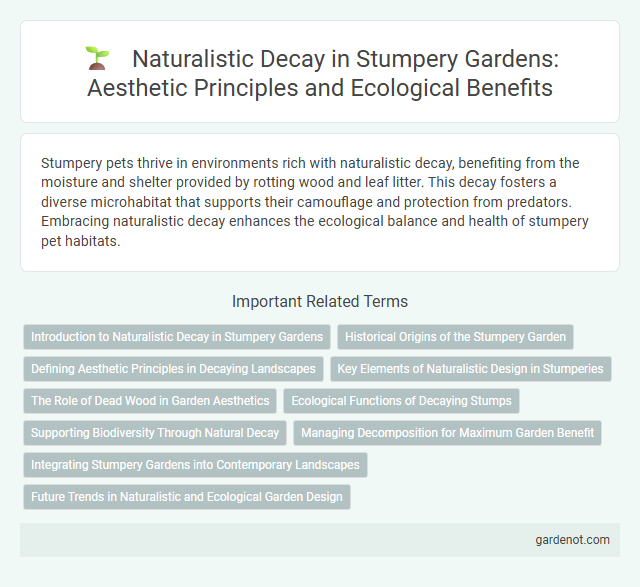Stumpery pets thrive in environments rich with naturalistic decay, benefiting from the moisture and shelter provided by rotting wood and leaf litter. This decay fosters a diverse microhabitat that supports their camouflage and protection from predators. Embracing naturalistic decay enhances the ecological balance and health of stumpery pet habitats.
Introduction to Naturalistic Decay in Stumpery Gardens
Naturalistic decay in stumpery gardens emphasizes the intentional use of decomposing tree stumps and organic debris to create habitats that support biodiversity and mimic woodland ecosystems. This approach encourages fungi, mosses, insects, and other decomposers to thrive, promoting nutrient cycling and soil health. By integrating naturalistic decay, stumperies become dynamic, sustainable garden features that blend aesthetics with ecological function.
Historical Origins of the Stumpery Garden
Stumpery gardens originated in the mid-19th century as Victorian enthusiasts sought to celebrate naturalistic decay by creatively arranging tree stumps, roots, and mosses. These gardens emulate woodland environments, emphasizing the beauty of decomposing wood and its role in supporting diverse ecosystems. The historical roots of stumperies align with the broader Victorian passion for fern collecting and botanical displays known as Pteridomania.
Defining Aesthetic Principles in Decaying Landscapes
Naturalistic decay in stumpery design emphasizes embracing the organic process of wood decomposition to create visually compelling textures and forms. This aesthetic principle highlights the beauty of aged bark, moss growth, and fungal patterns, reflecting the natural lifecycle within a garden setting. Prioritizing biodiversity and ecological sustainability, stumperies integrate decaying wood as habitat niches that enhance the overall sensory experience of the landscape.
Key Elements of Naturalistic Design in Stumperies
Stumperies showcase key elements of naturalistic design such as the deliberate use of decaying wood, moss, and ferns to mimic forest floor habitats. These structures emphasize organic forms and textures, integrating rotting tree stumps and branches to create a habitat-rich environment that supports biodiversity. The focus on naturalistic decay highlights ecological processes, promoting sustainability and fostering a dynamic, evolving garden feature.
The Role of Dead Wood in Garden Aesthetics
Dead wood in stumperies serves as a vital element in naturalistic garden design, enhancing biodiversity by providing habitats for fungi, insects, and mosses. Its textured, weathered appearance contributes to an organic aesthetic that contrasts with pristine garden features, promoting a rustic charm. Incorporating decaying wood mimics natural forest floors, supporting ecological balance and enriching the visual complexity of garden landscapes.
Ecological Functions of Decaying Stumps
Decaying stumps serve as vital ecological niches, supporting a diverse array of fungi, insects, and microorganisms that drive nutrient cycling and soil formation. These naturalistic decay processes enhance habitat complexity and promote biodiversity by providing shelter and food for various species. The decomposition of stumps also aids in carbon sequestration, contributing to sustainable forest ecosystem functions.
Supporting Biodiversity Through Natural Decay
Naturalistic decay in stumperies fosters diverse habitats by providing essential nutrients and shelter for fungi, insects, and small mammals. The gradual decomposition of wood supports soil health and promotes microbial activity, enhancing overall ecosystem resilience. Incorporating decaying wood elements contributes significantly to sustaining local biodiversity and ecological balance.
Managing Decomposition for Maximum Garden Benefit
Managing naturalistic decay in a stumpery enhances garden biodiversity by creating habitats for fungi, insects, and mosses that accelerate decomposition. Strategic placement of decaying logs and branches optimizes nutrient cycling, enriching soil health and promoting robust plant growth. Regular monitoring ensures balanced moisture and aeration, preventing rot while maximizing the ecological benefits of organic matter breakdown.
Integrating Stumpery Gardens into Contemporary Landscapes
Integrating stumpery gardens into contemporary landscapes emphasizes naturalistic decay by showcasing decomposing tree stumps and roots as sculptural elements that promote biodiversity and soil health. These features provide habitats for fungi, insects, and mosses, creating a living, evolving art form that complements modern garden design. Stumperies blend ecological function with aesthetic appeal, enriching landscapes through organic textures and sustainable practices.
Future Trends in Naturalistic and Ecological Garden Design
Naturalistic decay is increasingly embraced in future trends of ecological garden design, promoting biodiversity through the intentional preservation of decomposing wood and organic matter. This approach supports habitat creation for fungi, insects, and microorganisms essential to soil health and nutrient cycling. Gardeners and designers integrate stumperies as focal points that blend aesthetics with ecological function, fostering resilient and sustainable landscapes.
Naturalistic decay Infographic

 gardenot.com
gardenot.com